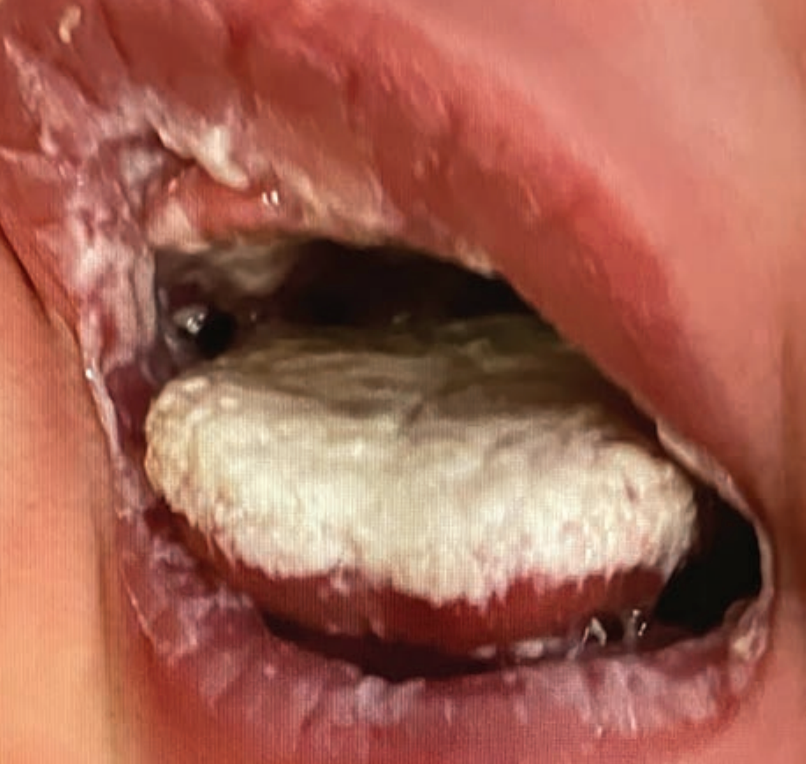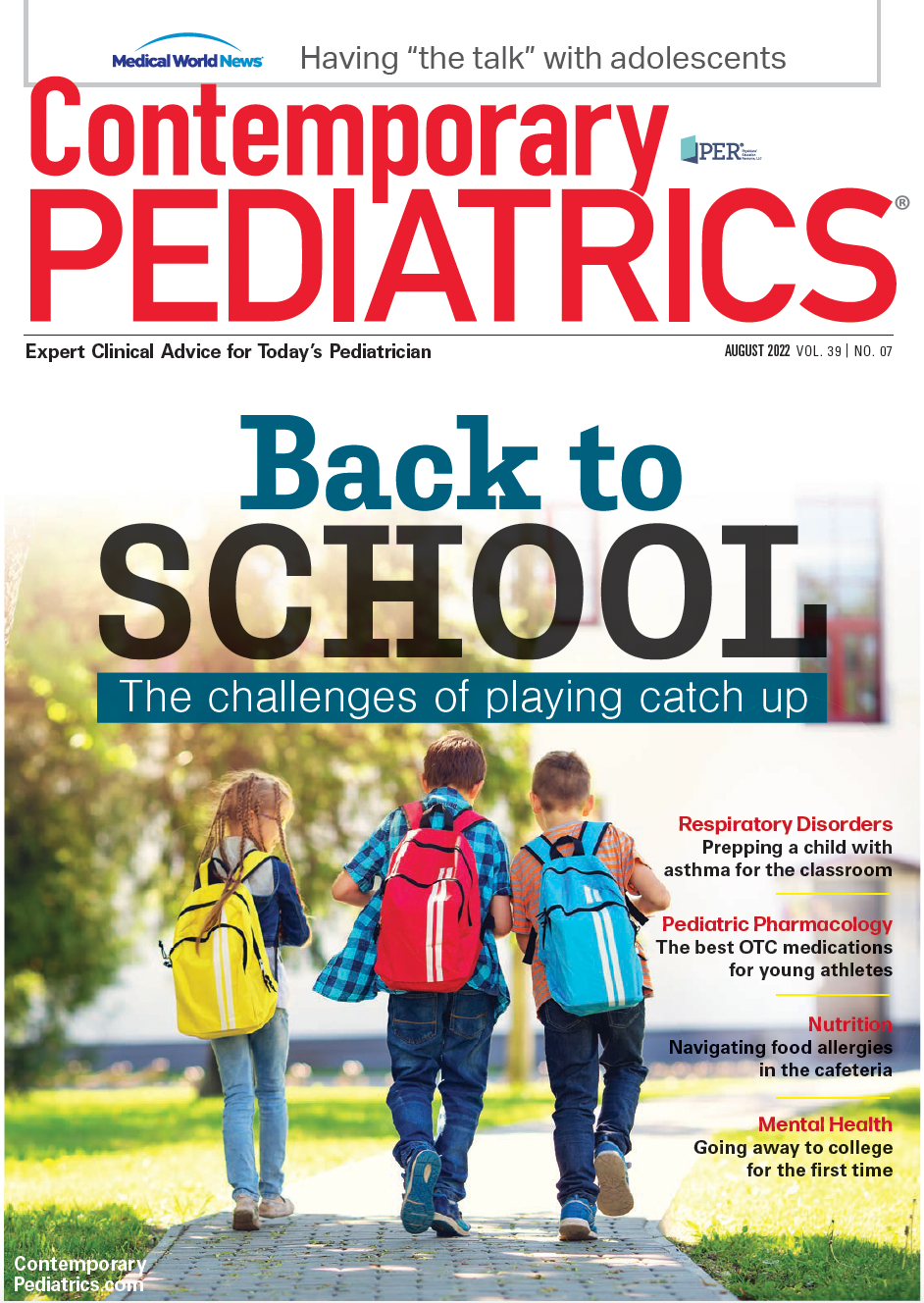White oral lesions in neonate with COVID-19
A 4-week-old boy presents with creamy white patches on his lips, right and left buccal mucosa, palate, and tongue.
In the hospital nursery, a 4-week-old boy has creamy white patches on his lips, right and left buccal mucosa, palate, and tongue. He had been admitted to the nursery intensive care unit (NICU) 2 days ago. His mother brought him to the pediatric emergency department because he refused to feed and felt warm. Seven days previously, his mother received a diagnosis of COVID-19 infection. He had a sepsis work-up and was started on intravenous (IV) antibiotics.
Diagnosis: COVID-19–associated pseudomembranous candidiasis
Hospital course
He was born at term via normal vaginal delivery with no complications. His mother received a diagnosis of gestational diabetes in the second trimester and was started on insulin.
Figure

On initial examination in the emergency department, he was noted to be moderately built and nourished, slightly irritable, and refusing to feed. His body temperature was 37.3 °C, heart rate was 134 beats per minute, oxygen saturation was 98%, and respiratory rate was 52. A chest x-ray showed no abnormal findings. A reverse transcriptase–polymerase chain reaction assay was positive for SARS-CoV-2.
He was admitted to the NICU after the sepsis work-up and treated with IV fluids and antibiotics. During hospitalization, he developed white creamy patches over the right and left buccal mucosa, palate, and tongue that on scraping left an erythematous, somewhat eroded mucosal surface. He also had red patches with superficial pustules in the diaper area. Microscopic examination revealed pseudohyphae and spores, and a fungal culture grew Candida albicans. He was treated with IV fluconazole once daily for 2 days and then transitioned to oral fluconazole for a week with complete clearing of the patches and a negative oral fungal culture on follow-up. Bacterial cultures were negative, and he was discharged home at the end of the week.
Discussion
Candida is a type of yeast, part of the fungus family that normally lives in and on our bodies.
It can be found on the skin and in the mouth, for example, and in the intestinal tract and genital area. Candidiasis infection of the mouth, also referred to as oral thrush, is common in infants and toddlers. Up to 37% of newborns may develop thrush during the first months of life. Most of the time, C albicans does not cause any problems. However, when it overgrows, it can cause infections ranging from simple asymptomatic oral candidiasis to life-threatening septicemia. Thrush also can affect fingernails, eyes, skin folds of the neck and armpits, as well as diaper area (Candida diaper dermatitis), including genital and perianal skin.
Causes
Male sex and birth asphyxia are predominant risk factors. It also has been observed that neonates developing candidiasis had received antibiotics such as amoxicillin or amoxicillin-clavulanic acid for a significantly longer duration. Newborns can get a Candida infection from their mothers. This can occur before delivery, but also during passage through the birth canal during delivery. Infants at the highest risk of bloodstream infections with Candida include premature or very low birthweight infants, children with long-term IV catheters, and children with weakened immune systems caused by HIV, cancers, or medicines. Children on inhaled steroids also have an increased incidence of oral candidiasis. Maternal risk factors also include diabetes mellitus and immunosuppressive states such as HIV. Risk factors for systemic candidiasis also include prolonged administration of total parenteral alimentation and IV fluids, and being on a ventilator.
Differential diagnosis
- Lichen planus is reticulated and erythematous rather than plaque-like. Twenty percent of oral lichenoid lesions will have superimposed candidiasis.
- Geographic tongue usually affects lateral/dorsal, rather than midline posterior, tongue.
- Oral hairy leukoplakia is an HIV-associated disease. It often has an associated secondary Candida infection and is most common on the lateral borders of the tongue, often (but not always) in a bilateral and symmetric distribution.
- Aphthous ulcers are much more painful and episodic than candidiasis.
- Chronic cheek chewing is usually painless, with a gelatinous, shaggy consistency.
- Hypersensitivity reaction to denture base material is rare.
- Diphtheria membrane can be mistaken for candidiasis, although in diphtheria there may be hemorrhagic crusts around the mouth and nares.
- Hairy tongue is hyperkeratosis of the filiform papillae, not a yeast infection.
- White sponge nevus is a very uncommon genodermatosis; there may be a family history.
- Leukoplakia presents as thick, white patches on the inside surfaces of the mouth. It can be a sign of precancerous changes in the mouth or mouth cancer.
- Uremic stomatitis is a rare disease affecting the oral mucosa and causing painful plaques and crusts. It is associated with acute or chronic advanced kidney failure.
Treatment
Oral thrush in infants often disappears within 2 weeks, and parents or caregivers may be advised to monitor the infection without using medication. The length and type of the therapy will depend on several factors, such as the severity of the infection and any other health problems. In case of chronic infection or severe immunodeficiency, topical application of clotrimazole (1%) 3 to 4 times a day with the maintenance of good oral hygiene is effective. However, resistant cases may require oral fluconazole or itraconazole. Fluconazole is available in convenient oral formulations for infants and children of 10 mg/cc and 40 mg/cc. In certain cases, nystatin also may be used.
Prevention
When a mother receives a diagnosis of gestational diabetes, she should be educated about candidiasis risk to her and to the baby. Women who have nipple discharge or pain during breastfeeding should notify their health care provider so they can be evaluated for yeast infection, which can be transmitted to the mouth of a nursing infant. When breastfeeding, women should use breast pads that do not have a plastic barrier. Long-lasting thrush is sometimes related to pacifiers or bottles that have not been properly cleaned.
Good oral hygiene is vital. If any chronic health issues are detected, they should be managed properly. If a patient is on inhaled corticosteroids, the inhaler should be cleaned properly and a spacer should be used. To reduce the risk of diaper candidiasis, change diapers often, especially if the patient has loose stools. Use a barrier cream as needed.


























